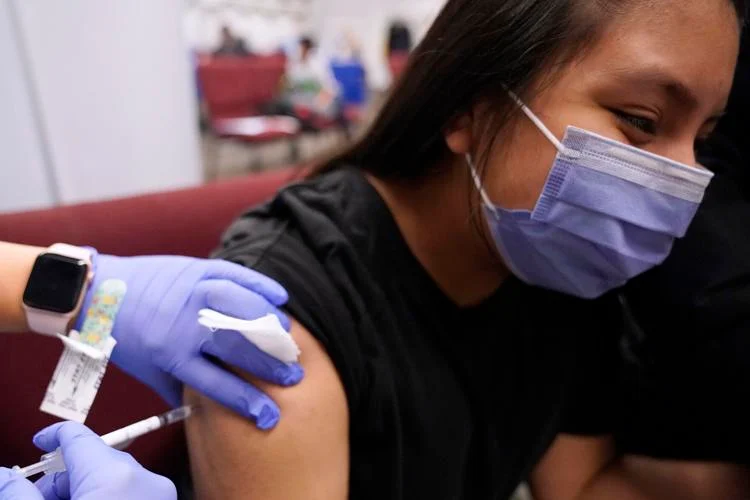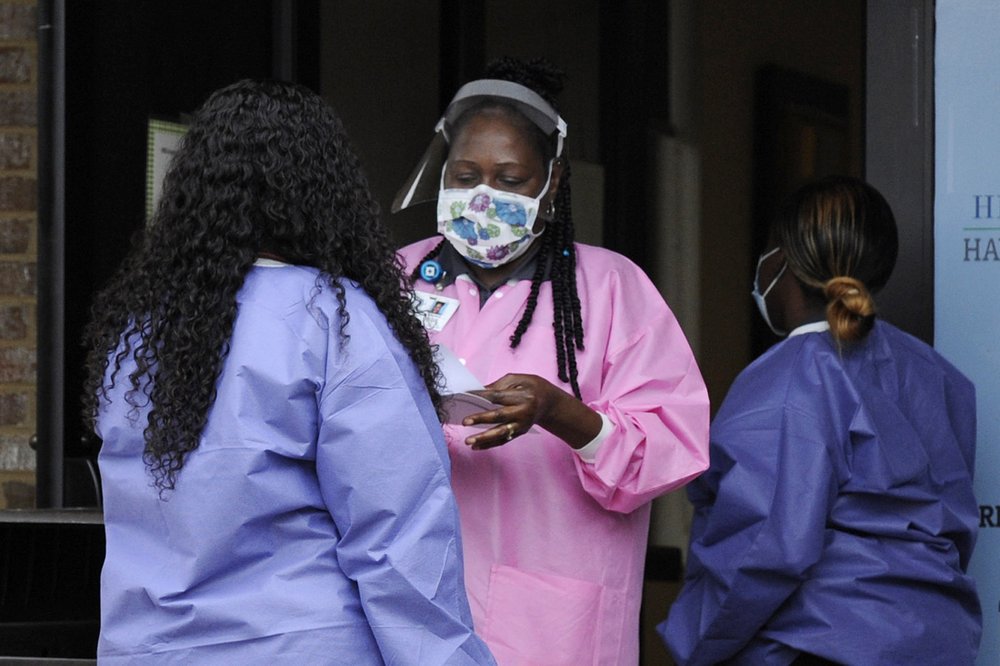Bill in Alabama Legislature would prohibit mask mandates

Alander Rocha, Alabama Reflector An Alabama representative filed a bill last week that would prevent the Alabama Department of Public Health (ADPH) and certain state government entities from enacting mask mandates. The bill, HB 9, sponsored by Rep. Brock Colvin, R-Albertville, would “prohibit governmental entities and the State Health Officer from imposing a face mask mandate to prevent the spread of COVID-19 or any other communicable disease.” “I don’t believe [the government] should have that authority,” Colvin said. “I think that people are smart enough to make those decisions for themselves. I just have that philosophical view that the government should have a very, very limited authority.” State, counties, municipalities, or any instrument of those entities, as well as public K-12 schools or public charter schools, would be prohibited from enacting mask mandates. The bill would provide exceptions to any medical facility licensed by the ADPH and state and local detention centers. There are no sanctions or punishments for failure to comply in the pre-filed bill. Several states, mostly Republican-leaning, have passed anti-masking regulations since the COVID-19 pandemic, including Arizona, Florida, and Texas. Arkansas imposed a similar restriction that was overturned by a state judge in December 2021. Other states, such as Tennessee and Georgia have laws giving parents the right to opt their children out of masking. The COVID-19 virus has killed over 22,500 people in the state since the first Alabama case was confirmed on March 13, 2020. At its peak in the state in the fall of 2021, up to 3,000 people were hospitalized each day for COVID. In an email statement, State Health Officer Dr. Scott Harris said during COVID-19, the federal government provided ADPH guidance in implementing certain mandates to protect public health, in response to the “once-in-a-lifetime circumstances.” But Harris said that the bill should stick with COVID-19 and not include all existing or potential communicable diseases. “There could be existing or evolving respiratory diseases where preventative health measures could effectively mitigate widespread outbreaks,” Harris said in the statement. Colvin’s bill goes further than a bill introduced in the 2023 legislative session that would allow parents to opt out of masking in K-12 public schools. The bill passed the House Health Committee but did not advance to the House floor. Rep. Chip Brown, R-Hollinger’s Island, at the time said the bill was not an “anti-school bill” or an “anti-masking bill,” but a “parental rights bill.” Colvin said that this bill is about personal freedom, and that he’s not trying to address the science behind masking in the bill. “I’m not even arguing the science on whether they work or not,” he said. “I’m just saying I don’t think the government has the authority to tell individuals what to do in terms of this.” Harris stated that it’s not ADPH’s goal to restrict personal freedoms and rights, but that it’s imperative to keep Alabamians safe at all costs. “ADPH has an obligation and a duty to the citizens of Alabama to promote, protect, and improve Alabama’s health,” the statement read. Colvin, a first-term representative and financial planner, is running for Alabama Senate District 9, which includes Blount, Madison, and Marshall counties. The seat was previously held by Clay Scofield, R-Arab, who stepped down to take a job with the Business Council of Alabama. Alabama Reflector is part of States Newsroom, a network of news bureaus supported by grants and a coalition of donors as a 501c(3) public charity. Alabama Reflector maintains editorial independence. Follow Alabama Reflector on Facebook and Twitter.
Congressional candidate Ken McFeeters opposes proposed ADPH COVID rule

On Wednesday, Republican Congressional candidate Ken McFeeters announced his opposition to a proposed Alabama Department of Public Health (ADPH) new rule requiring all the healthcare providers in the state to report every positive COVID-19 test in their office to ADPH. The proposed new rule would reportedly even require the doctors to report every suspected COVID-19 case that comes into the office to state authorities. McFeeters condemned the proposed change in COVID-19 reporting requirements. McFeeters is running for the GOP nomination for Congressional District 6. The proposed rule changes would require all positive tests for COVID-19 and SARS-CoV-2 to be reported to the County or State Health Department within 24 hours. ADPH released the proposed changes on November 20, 2023. The new rules would put positive COVID test results in the same category as Rabies, Polio, Tuberculosis, and Legionairre’s disease. “This is just another example of the idiotic policies of ADPH and Dr. Scott Harris, our State Health Officer,” McFeeters said in a statement. “Dr. Harris got everything wrong during the COVID pandemic, and now he wants more power over us? To demand that every positive COVID test be reported to the Health Department within a day is ridiculous.” McFeeters is concerned that the new rule further infringes on Americans’ privacy rights. “The COVID tests are notoriously unreliable,” McFeeters continued. “The number of false positives they give is too high. A positive test in a person with no symptoms doesn’t merit an urgent call to ADPH to give them your age, sex, address, ethnicity, phone number, and birthday.” McFeeters told Alabama Today that the economy never should have shut down in 2020 over COVID. He is also skeptical of the vaccine’s effectiveness and believes that the suspected side effects outweigh the benefits of mass vaccination. “COVID isn’t rabies. It’s not TB. Yes, it’s dangerous for the old and sick, but for most of us, it’s just a cold,” McFeeters continued. “Dr. Harris and ADPH have been either clueless or complicit throughout the COVID pandemic. Scott Harris has been a good little drone, carrying out the orders of Drs. [Anthony] Fauci and [Rochelle] Walensky, pushing lockdowns, mandates, and treatment protocols that left thousands dead. At the same time, he’s touted the Big Pharma party line and worked to marginalize courageous doctors who were treating sick people and saving lives.” McFeeters continued, “We don’t need this hysteric, intrusive level of reporting for COVID tests. What we do need is accountability for Dr. Harris and ADPH for the tens of thousands of Alabamians killed or injured by their COVID mismanagement, their deadly “treatments,” and the toxic jabs they forced on us.” A public hearing on the proposed reporting changes will be held on December 13, 2023 at 9:00 a.m., at the Alabama Department of Public Health, RSA Tower, Training Room 982, 201 Monroe Street in Montgomery. Ken McFeeters co-founded PAC Insurance Agency at age 21, and has worked there for the last 42 years. McFeeters is a father and grandfather. McFeeters said in his statement that he is running for Congress to disrupt Washington’s toxic culture of deceit and corruption and protect everyday Americans. McFeeters will face incumbent Congressman Gary Palmer and businessman Gerrick Wilkins in the Alabama Republican primary on March 5. The eventual Republican nominee will face Democratic nominee Elizabeth Anderson in the November 5 general election. To connect with the author of this story or to comment, email brandonmreporter@gmail.com.
Alabama’s overall infant mortality rate dropped – Black infant mortality rose; White infant mortality dropped

The Alabama Department of Public Health (ADPH) announced Thursday that the 2022 Alabama infant mortality rate was 6.7 deaths per 1,000 live births. That is a substantial decrease from the 7.6 rate in 2021. Despite this improvement, Alabama’s infant mortality rate remains higher than the provisional U.S. rate of 5.6 for 2022. While Alabama’s rate improved, the national rate trended upward for the first time in 20 years. The substantial racial disparities in infant mortality got much worse in 2022, though. Black mothers have the highest infant mortality rate in the state. The rate increased to 12.4 in 2022. That is up from 12.1 in 2021. White infant mortality rate, however, improved, dropping from 5.8 to 4.3 for White mothers. “I am pleased that both the 2022 infant mortality rate and the 3-year infant mortality rate of 7.1 for 2020-2022 have decreased to the lowest rate ever,” said Alabama State Public Health Officer Dr. Scott Harris. “Births with maternal smoking also declined to the lowest ever recorded. The enduring disparity between birth outcomes for Black and white mothers, however, is disturbing. Despite advances in healthcare, the Black infant mortality rate is consistently twice the rate for white mothers. We must address the many factors that contribute to infant mortality, including poverty, educational levels, and access to medical care.” Dr. Max Rogers is a State Committee of Public Health member. “We are heartened to learn that Alabama’s infant mortality rate declined in 2022,” said Dr. Rogers. If this positive trend is to continue, we must follow evidence-based practices that have been shown to save lives, such as providing access to timely, adequate prenatal care.” Dr. Eli Brown is another State Committee of Public Health member. “As an obstetrician/gynecologist who focuses on women’s health and delivering babies, I am troubled that a major predictor of whether a mother will deliver a baby preterm is her race. Improving outcomes for Black infants, along with infants of all races and ethnicities, is imperative,” said Dr. Brown. “Births to mothers in hospitals which have a higher volume of deliveries improve the chance of healthy survival for high-risk infants.” There were 58,162 births in Alabama in 2022, up slightly from 58,040 in 2021. Just 391 babies died in 2022. This is down from 443 infant deaths in 2021. The percentage of low-weight births decreased very slightly from 10.5 to 10.4. The percentage of births at less than 37 weeks of gestation also decreased from 13.1 to 12.8%. Low birth weight is defined as birth weight under 2,500 grams. Providing adequate prenatal care remains a problem. The percentage of births with adequate prenatal care decreased from 74.8 percent to 74.4 percent, and the percentage of births with no prenatal care increased from 2.2 percent to 2.3 percent in 2022. For births with no prenatal care, 60.0 percent were to white mothers, 21.2 percent were to Black mothers, and 18.8 were to mothers of other races. Medicaid was the payment source for 77.3 percent of births without prenatal care, and the majority of births to mothers with no prenatal care, 54.3 percent, were to mothers aged 20 to 29. Teenagers giving birth continue to decline; however, the percentage of births to white teen mothers increased from 5.4 to 5.5 percent. There was a decrease in births to Black teen mothers in 2022 from 8.5 to 7.2%. The percentage of births with maternal smoking was 4.8 in 2022. That is a substantial decrease from 6.1 in 2021. That is the lowest percentage ever recorded in Alabama. To connect with the author of this story or to comment, email brandonmreporter@gmail.com.
State releases the Alabama Physical Activity and Nutrition Plan to improve health behaviors

The Alabama Wellness Alliance (AWA), previously known as the Alabama Obesity Task Force, has released the Alabama Physical Activity and Nutrition Plan (ALPAN). ALPLAN is supported by the governor of Alabama and the state health officer. AWA said in a statement that low rates of physical activity, poor nutritional intake, food insecurity, chronic diseases, and obesity are public health concerns throughout the United States, especially in Alabama. Governor Kay Ivey, Dr. Scott Harris, as well as leaders and decision-makers in the state, recognize the significant impact of a healthy diet and adequate physical activity on improving health outcomes. “The stated mission of the Alabama Wellness Alliance, which produced this Alabama Physical Activity and Nutrition Plan, is creating a healthier Alabama through obesity reduction and prevention efforts,” said Gov. Ivey. “Eating a healthy diet and getting adequate exercise can reduce obesity. Suggested strategies for individuals to improve physical activity and nutrition are included in the report.” “Everyone has a role to play in making Alabama a healthier place to live, but doing so will require collaboration and strong partnerships,” explained Dr. Harris. “I encourage you to take ownership of this plan, working with partners to identify the strategies that can be successfully implemented in your community. The plan is our road map to a healthier state, and it will facilitate consistent and collaborative efforts that will enable Alabama to achieve better health outcomes by supporting healthy lifestyle behaviors.” The ALPAN utilizes the Social Ecological Model to provide a roadmap for creating a healthier Alabama through practical, evidence-based physical activity and nutrition strategies to produce long-term health benefits for individuals in the state. Members and non-members of the AWA from a wide range of regions and multidisciplinary sectors of the state contributed their expertise, knowledge, and experience to develop a realistic, achievable, and appropriate plan for Alabama. The plan sets goals, detailed objectives, and recommendations for physical activity and nutrition strategies for sectors across the state. These sectors included in the plan are business and industry; education; fitness and sports; healthcare; non-profit organizations; faith-based organizations; public health; public lands, parks, and recreation; and transportation, community planning, and access. The ALPAN seeks to address health disparities and ensure every person can achieve optimal health regardless of where they work, live, worship, and play. Policymakers, health professionals, and all Alabamians are encouraged to access and utilize the ALPAN, which can be found here: According to the Centers for Disease Control and Prevention (CDC), Alabama is the third most obese state in the nation, with 39.9% percent of the adult population being overweight. Additionally, 17% of Alabama high school students are overweight, and 17.3% of children aged 10 to 17 are overweight. County health departments throughout Alabama provide a wide range of confidential and professional services. Their mission is to promote, protect, and improve Alabama’s health. Contact your local county health department for additional information. To connect with the author of this story or to comment, email brandonmreporter@gmail.com.
COVID-19 public health emergency will expire on Thursday

The Alabama Department of Public Health (ADPH) announced on Tuesday that the federally declared public health emergency for COVID-19 will expire on Thursday. Case numbers, hospitalizations, and deaths from COVID-19 are significantly lower now than during surges of the virus. ADPH will continue providing COVID-19 testing and vaccines for uninsured/underinsured people at the local county health departments even after the public health emergency ends. Even though the emergency is no longer in effect, COVID-19 remains a clear and present danger. “Although the COVID-19 pandemic is entering a new phase, the disease is still causing suffering and death in Alabama,” State Health Officer Dr. Scott Harris said. “ADPH is committed to monitoring the effects of this virus in Alabama and will continue to provide data that is accurate and actionable.” For the past three years, ADPH has had access to a large amount of COVID-19 data, some of which had been required to be submitted to the federal government. As these requirements transition, COVID-19 will continue to be reportable in Alabama, but some data will no longer be available. The current COVID-19 dashboards will be modified to use the available data and to better align with data from the Centers for Disease Control and Prevention (CDC). The current Alabama COVID-19 dashboards will update for a final time this week and be available for archive purposes for an unspecified amount of time. ADPH will continue to publish hospital admission data and COVID-19 death data which will be updated, but its reporting frequency will change. Vaccine administration reporting will not be reported as ADPH will no longer receive data from vaccine providers. ADPH continues to recommend the Bivalent COVID-19 Vaccines. The Centers for Disease Control and Prevention (CDC) has simplified its COVID-19 vaccine recommendations. Among the recommendations are that adults ages 65 and older and immunocompromised adults can receive a second dose of the updated vaccine. The CDC recommends that children ages six and older and adults receive an updated bivalent mRNA COVID-19 vaccine, regardless of whether they previously completed their (monovalent) primary series. Alternatives to mRNA COVID-19 vaccines remain available for people who cannot or will not receive an mRNA vaccine. The federal supply of COVID-19 vaccine will be available at no charge until the current supply is exhausted. After this supply of COVID-19 vaccine has been depleted, the vaccine will be sold commercially. People with public or private insurance will continue to be able to access authorized COVID-19 vaccines. For the uninsured, the federal government has announced it will fund a program to keep COVID-19 vaccines free after the vaccines move to the private market. A new partnership will cover the administrative costs of giving doses of vaccines at pharmacy chains and county health departments to uninsured people. Some doctors remain skeptical of the effectiveness and safety of the COVID-19 vaccines, which use experimental mRNA technology. The end of the public health emergency also means there will be changes in the availability of free COVID-19 tests. People covered by Medicaid can access free at-home tests through September 2024. The ADPH will continue to monitor COVID-19 as it regularly monitors other respiratory diseases and will respond to any future surges or developments. COVID-19 is caused by the SARS-CoV-2 virus – a type of coronavirus. 1,162,474 Americans have died, including 21,137 Alabamians, in the COVID-19 global pandemic. 107 million Americans contracted the virus despite efforts to limit the spread of the virus. To connect with the author of this story or to comment, email brandonmreporter@gmail.com.
Legislature passes bill to give nonviable birth certificates to mothers who lost a pregnancy

On Tuesday, the Alabama Legislature passed bipartisan legislation allowing mothers whose preborn child was lost due to miscarriage to apply for and receive a state-issued birth certificate for that child whose life ended prematurely. House Bill 55 (HB55) is sponsored by State Representative Juandalynn Givan. Givan explained in committee that she was asked to carry this legislation by a woman she met at a town hall, who had lost her child, Genesis, to miscarriage. Givan agreed to carry the bill after other mothers approached her with similar stories. Givhan explained to the House Health Committee that she has spoken with State Health Officer Dr. Scott Harris and that he has agreed for the Department of Public Health to prepare the nonviable birth certificates. Givan explained that the Department already provides these but only for pregnancies lost at 20 weeks or later. HB55 extends that to earlier pregnancies. Rep. Givan explained that Florida was the first state to pass this legislation. Since then, other states have followed. Givan explained that mothers who have lost a child, even in the womb, feel a great sense of loss that deeply affects them. The legislation received favorable recommendations from both the House and Senate Health Committees. The Senate passed the legislation 33 to 0 on Tuesday. The legislation has already passed the House of Representatives. It now goes to the Governor for her consideration. According to the synopsis, “Under existing law, a nonviable birth that occurs before the twentieth week of gestation is not reported to the Office of Vital Statistics, and a parent of a nonviable birth that occurs before the twentieth week of gestation may not request a certificate of birth. Also, under existing law, a parent of a fetal death occurring after 20 weeks of gestation may request a Certificate of Birth Resulting in Stillbirth. This bill would create the Genesis Act to require the Alabama Department of Public Health to adopt rules allowing for the parents of a nonviable birth occurring before the twentieth week of gestation to request a Certificate of Nonviable Birth.” HB55 now goes to Governor Kay Ivey’s desk for her consideration. Wednesday will be Day 17 of the 2023 Alabama regular session. To connect with the author of this story or to comment, email brandonmreporter@gmail.com.
House Committee advances bill to allow mothers to receive birth certificates for a child lost from miscarriage

On Wednesday, the Alabama House Health Committee voted to give a favorable report to legislation allowing mothers whose preborn children were lost due to miscarriage or through a stillbirth to receive a state-issued birth certificate. House Bill 55 (HB55) is sponsored by State Representative Juandalynn Givan. “I have the honor today to present to you HB55, which, if entitled, will be called the Genesis Act,” Givan said. According to the synopsis, “Under existing law, a nonviable birth that occurs before the twentieth week of gestation is not reported to the Office of Vital Statistics, and a parent of a nonviable birth that occurs before the twentieth week of gestation may not request a certificate of birth. Also, under existing law, a parent of a fetal death occurring after 20 weeks of gestation may request a Certificate of Birth Resulting in Stillbirth. This bill would create the Genesis Act to require the Alabama Department of Public Health to adopt rules allowing for the parents of a nonviable birth occurring before the twentieth week of gestation to request a Certificate of Nonviable Birth.” Givan said that she is representing the mothers who have lost children before the twentieth week of gestation and that they want to be able to petition the state for documentation on the loss of that preborn child. “I want someone to know that the life that I carried mattered,” Givan said that the mothers supporting this legislation feel. “I want someone to know that that baby was loved and mattered to me.” “After 20 weeks of gestation, a parent can request a birth certificate from the Health Department,” Givan said, explaining that her bill would extend that to include pregnancies lost between ten weeks and nineteen weeks. Givan said that HB55 would permit the State Department of Health to do so and that the Health Department supports the legislation. “Dr. Scott Harris (the state health officer) shared the story of how his mother went through the same thing when young in life,” Givan said. State Rep. Paul Lee, a Republican from Dothan, chairs the House Health Committee. “Everyone received the amendment last night, and it is in your packet,” Chairman Lee said. The Committee voted to adopt the amendment. Givan explained that the Health Department would issue the nonviable birth certificate within 50 days after the request is made. “Florida was the first state to pass this into law in 2019,” Givan explained. “Other states have followed.” Rep. Phillip Rigsby motioned to give the bill a favorable report. The Committee voted unanimously to give HB55 a favorable report. HB55 could be considered by the full Alabama House of Representatives as early as Tuesday. Givan was joined in the committee hearing by a delegation of mothers whose children had been lost through miscarriage. Givan introduced the mothers to the Committee and thanked the members for the favorable report. As of Monday, 471 bills have been filed in the 2023 Alabama Regular Legislative Session. Tuesday will be day 8 of the regular session. The Alabama Constitution limits the regular session to no more than thirty legislative days during a regular session. To connect with the author of this story or to comment, email brandonmreporter@gmail.com.
835 Alabamians killed by fentanyl in 2022

The surge of fentanyl in the state has resulted in increased deaths from the deadly drug. Alabama State Public Health Officer Scott Harris reports that fentanyl deaths have gone from 121 in 2018 to 835 in 2022. “Fentanyl abuse is a crisis nationwide, and the state of Alabama is no exception,” Harris reported in his recent column. “Alabama has experienced an alarming increase in the number of fentanyl-related overdose deaths in recent years—from 121 in 2018 to 193 in 2019, and to 428 in 2020. Preliminary numbers show 830 Alabama resident deaths in 2021 and 835 deaths in 2022 related to this powerful drug.” Fentanyl deaths were up in 2022 even though paramedics, police departments, schools, churches, and even parents are increasingly prepared to respond to overdose emergencies with products such as Narcan. ADPH is part of a statewide education campaign to inform the public about the dangers of the drug. “Our department is committed to fighting this growing epidemic and has joined a group of statewide organizations that have launched the “Odds Are Alabama” campaign to prevent fentanyl-related overdose deaths and poisonings,” Dr. Harris continued. “Other campaign sponsors include the following concerned organizations and agencies: Alabama Chapter of the Academy of Pediatrics, Alabama Chapter of the American College of Emergency Physicians, Alabama Department of Mental Health, Alabama Hospital Association, Blue Cross and Blue Shield of Alabama, Medical Association of the State of Alabama, Scout Branding Company, and VitAL Alabama.” “About two-thirds of all overdoses nationwide are attributed to synthetic drugs like fentanyl,” Dr. Harris explained. “While the synthetic opioid fentanyl was originally developed for pain management in cancer patients, illegal drug manufacturers have abused it by adding fentanyl to other drugs to increase their potency. Criminal drug networks are mass-producing counterfeit pills to deceive the public.” On Thursday, Governor Kay Ivey signed legislation that set mandatory minimum sentences for persons convicted of trafficking in fentanyl. “The entire nation should take note of what we accomplished today in Alabama with the passage of House Bill 1, the bill to help combat the fentanyl crisis,” Ivey said. “Every member of the Legislature – Republican and Democrat – came together to pass this critical piece of legislation.” Under this legislation, a person found with just six grams of fentanyl could spend the rest of their life as a guest of the Alabama Department of Corrections if convicted. “Combatting this deadly drug will continue to be a top priority for our Alabama Law Enforcement Agency, and I will do everything in my power to stop this drug from being a killer in Alabama,” Ivey said. “I commend Rep. Matt Simpson for his leadership on this issue, as well as all members of the Alabama Legislature for sending this bill to my desk.” Dr. Harris points out that drug dealers are selling fake prescription drugs that are, in reality, highly addictive fentanyl. “Many fake pills are made to look like prescription drugs such as oxycodone (Oxycontin®, Percocet®), hydrocodone (Vicodin®), and alprazolam (Xanax®); or stimulants like amphetamines (Adderall®),” Harris said. “Six of 10 counterfeit prescription pills analyzed by the DEA Laboratory in 2022 contained a potentially deadly dose of fentanyl. A lethal dose of fentanyl is only about 2 milligrams, equivalent to just a few grains of salt. Fentanyl is inexpensive to manufacture, and in 2021 the DEA seized enough fentanyl to kill every American. In addition to pills, fentanyl is found in capsule form and can be disguised as gummies or candies to attract children.” Narcan, administered as a nasal spray, is now available over the counter. In addition to Narcan, naloxone is available in an injectable form and in other doses. The other formulations and dosages of naloxone will remain available by prescription only. Dr. Harris has a standing order in place that allows pharmacists to dispense naloxone formulations and dosages that are prescription only. Medicaid patients can access naloxone through prescription. “The Alabama Pharmacy Association applauds the FDA’s decision to make this life-saving drug available without a prescription to anyone who needs it,” said Louise Jones, APA chief executive officer. “Only the Narcan 4 mg nasal spray version has been approved for over-the-counter (OTC) use. The Alabama current statewide standing order issued by the state health officer will remain in place as the injectable version will still require a prescription. It should be noted that Alabama Medicaid recipients have coverage for the nasal spray, but Medicaid requires a prescription for OTC products. APA, in collaboration with the Alabama Department of Public Health and Alabama Medicaid, has worked to maintain access for our state’s most vulnerable population.” Given the growing propensity of drug dealers to spike their products with fentanyl, do not buy anything from street dealers or shadowy pharmacy sales sites. To connect with the author of this story or to comment, email brandonmreporter@gmail.com.
Infant mortality in Alabama increased 8.6% in 2021

On Thursday, the Alabama Department of Public Health (ADPH) announced that in 2021, 443 Alabama infants died during their first year of life. Alabama infant mortality was up significantly in 2021 over 2020. The death rate for children one year or less was 7.6 deaths per 1,000 live births in 2021. That is up from 7.0 in 2020. The state’s infant mortality for 2021 is an 8.6 percent increase over 2020. Alabama’s infant mortality rate is significantly higher than the national average for 2021 of 5.5 deaths per 1,000 births. Infant deaths, fetal deaths, live births, and estimated pregnancies all increased in Alabama from 2020 to 2021. Black mothers continue to have the highest infant mortality rate in the state. In 2021, the rate increased to 12.1 from the 2020 rate of 10.9. By comparison, the infant mortality rate for White mothers was 5.8. That, however, represents an increase from 5.2 in 2020. The infant mortality rate declined among Hispanic mothers from 7.2 (37 infant deaths) in 2020 to 5.2 (29 infant deaths) in 2021. “While there were several positive indicators of progress in 2021, decreasing infant mortality remains a significant challenge,” said State Health Officer Dr. Scott Harris in a statement. “Infant mortality is closely related to social determinants of health, such as race, poverty, and education. Alabama must continue our commitment and efforts to prevent infant deaths by promoting evidence-based initiatives such as home visiting nurses to first-time mothers and high-risk pregnancies, safe sleep education, and the ‘Count the Kicks’ campaign.” While the recent spike in infant mortality is disturbing, the general trend over time has been for infant mortality to decrease. In 2016 infant mortality was 9.6 deaths per thousand – significantly higher than in 2021. The number of births to mothers in Alabama rose from 57,643 in 2020 to 58,040 in 2021. The number of births to Black mothers declined from 20,151 in 2020 to 19,170 in 2021. However, births to White mothers increased from 37,492 in 2020 to 38,870 in 2021. The 5,598 births to Hispanic mothers in 2021 were the highest seen among the ethnic category in the past decade. The percentage of low-weight births decreased from 10.8% to 10.5%; however, the percentages of births at less than 37 weeks of gestation and births with a birth interval of less than 2 years increased in 2021. The percentage of births with no prenatal care decreased from 2.6 percent to just 2.2%. For births with no prenatal care, 52.5 percent were to white mothers, 52.4 percent were to mothers aged 20-29, and 74.7 percent were paid by Medicaid. The overall number of births to teenagers continues to decline; however, the percentage of births to Black teen mothers increased slightly increased in 2021, from 8.3 to 8.5. The percentage of births with maternal smoking was just 6.1% in 2021. That is the lowest percentage ever recorded since ADPH began keeping records on maternal smoking. To connect with the author of this story, or to comment, email brandonmreporter@gmail.com.
Alabama health officer Dr. Scott Harris tests positive for COVID-19

Alabama’s top health official said Wednesday that he has tested positive for COVID-19 and is showing only mild symptoms. State Health Officer Dr. Scott Harris, in a statement, said he tested positive on Tuesday. “Fortunately, I am fully vaccinated and have already received my second booster,” he said. Harris said he plans to work from home and adhere to isolation standards suggested by the Centers for Disease Control and Prevention. “While case numbers have declined recently in Alabama, this serves as a reminder that COVID-19 continues to circulate in our state,” Harris said. “The single best way to prevent serious illness or death is to be fully vaccinated and boosted.” Republished with the permission of the Associated Press.
Alabama covid cases down below 5%, first time since omicron surge

Alabama’s positivity rate for COVID tests over the last seven days fell below 5% for the first time since the start of the omicron surge, reported AL.com. According to the Alabama Department of Public Health (ADPH), Alabama’s positivity rate hasn’t been this low since before the delta surge. Data from the Covid-19 Dashboard show 4% of COVID tests performed in the state over the last seven days have come back positive, the lowest in almost nine months. Cases and hospitalizations also continue to decline. There were just over 400 COVID hospitalizations statewide as of Sunday, the lowest number since Christmas. The state has been averaging between 500 and 1,000 cases per day since late February. However, during the peak of the omicron wave, there were nearly 10,000 cases reported per day. On Twitter, the ADPH stated, “ADPH will be endorsing the new community levels recently released by @CDCgov. Our #COVID19 Data & Surveillance Dashboard will reflect these new measures soon. The dashboard will only be updated Monday-Friday instead of daily.” State Health Officer Dr. Scott Harris stated in a press release, “The solid red high-risk map indicating overall level of community transmission seen over the past 2 months in the state is now colored in the low, moderate, or substantial risk levels in a majority of counties, and the percent positivity in tests is under 10. As we enter our third year battling COVID-19, more than half of the state’s population is fully vaccinated.”
U.S. vaccination drive is bottoming out as omicron subsides

A handwritten log kept by nurses tells the story of the losing battle to get more people vaccinated against COVID-19 in this corner of Alabama: Just 14 people showed up at the Marion County Health Department for their initial shot during the first six weeks of the year. That was true even as hospitals in and around the county of roughly 30,000 people filled with virus patients and the death toll climbed. On many days, no one got a first shot at all, while a Mexican restaurant up the street, Los Amigos, was full of unmasked diners at lunchtime. The vaccination drive in the U.S. is grinding to a halt, and demand has all but collapsed in places like this deeply conservative manufacturing town where many weren’t interested in the shots to begin with. The average number of Americans getting their first shot is down to about 90,000 a day, the lowest point since the first few days of the U.S. vaccination campaign in December 2020. And hopes of any substantial improvement in the immediate future have largely evaporated. About 76% of the U.S. population has received at least one shot. Less than 65% of all Americans are fully vaccinated. Vaccination incentive programs that gave away cash, sports tickets, beer, and other prizes have largely gone away. Government and employer vaccine mandates have faced court challenges and may have gone as far as they ever will. And with COVID-19 cases, hospitalizations, and deaths subsiding across the U.S., people who are against getting vaccinated don’t see much reason to change their minds. “People are just over it. They’re tired of it,” said Judy Smith, administrator for a 12-county public health district in northwestern Alabama. The bottoming-out of demand for the first round of vaccinations is especially evident in conservative areas around the country. On most days in Idaho, the number of people statewide getting their first shot rarely surpasses 500. In Wyoming, a total of about 280 people statewide got their first shot in the past week, and the waiting area at the Cheyenne-Laramie County Health Department stood empty Tuesday morning. The head of the department fondly recalled just a few months ago, when the lobby was bustling on Friday afternoons after school with children getting their doses. But they aren’t showing up anymore either. “People heard more stories about, well, the omicron’s not that bad,” Executive Director Kathy Emmons said. “I think a lot of people just kind of rolled the dice and decided, ‘Well, if it’s not that bad, I’m just going to kind of wait it out and see what happens.’” Marion County, along the Mississippi line, is part of a band of Alabama counties where most people aren’t fully vaccinated more than a year after shots were rolled out. Just to the east, Winston County has the state’s lowest share of fully vaccinated residents, at 26%, according to the Centers for Disease Control and Prevention. About 42% are fully immunized in Marion County. The digital sign outside First National Bank flashes Bible verses along with the temperature, and many Marion County residents work in small plants that make mobile homes and components for prefab housing. Most area jobs are blue-collar, and TVs are typically turned to Fox News. A conservative, working-class ethic runs deep. The area went heavily for President Donald Trump in the 2020 election. And yet resistance to the vaccine is so strong that two counties over, in Cullman, some booed Trump when he encouraged vaccinations during a rally that drew thousands last summer. COVID-19 has killed almost 18,000 people in Alabama, giving the state the nation’s fourth-highest rate of deaths relative to population. Marion County’s rate exceeds the state average at 1.78%, with more than 140 deaths, according to data from Johns Hopkins University. Health officials expected to have a hard time persuading Black people to get government-sponsored vaccines in Alabama, home of the infamous Tuskegee syphilis study and a place where distrust of Washington runs deep. They started work on public education campaigns weeks early in mostly Black areas, which now have some of the state’s highest vaccination rates, at 60% or more. But they didn’t expect the stiff resistance among rural whites that has kept vaccination numbers stubbornly low in places like Marion County, which is 94% white. While rural transportation difficulties, confusion over vaccine costs — they’re free — and a lack of health care access have also been factors, the partisan divide in America killed the vaccine drive for some before it really got started, officials said. “Rural white men who identify as conservative are just not interested in this. That caught us off guard,” said Dr. Scott Harris, head of the Alabama Department of Public Health. “By the first or second month of the vaccine campaign, it became clear that those folks just weren’t going to come in.” Richard Kitchens is among that group. The owner of a clothing and sports shoe shop on the square in Hamilton, Kitchens said he isn’t interested in the vaccine after getting COVID-19 in 2020 before vaccines were available and having relatives who contracted the illness developed only minor symptoms and recovered. Short of a proven guarantee against illness — which no vaccine provides — he doesn’t see the point. “I guess if I knew I could go out and get a shot and wouldn’t get it or spread it, I would go get it, and they say it helps,” Kitchens said. “But I think that will be determined sometime down the road maybe.” Doris Peterson is fully vaccinated, but she said she didn’t get a booster on the advice of her two adult daughters, neither of whom is vaccinated. Peterson said she is used to being one of the few people around still wearing a mask in public. “Most of the time I am it,” she said. Kelly Moore, a former Tennessee health official who now heads a CDC-funded vaccination advocacy organization named Immunize.org, recalled seeing data from a recent survey that hit her like a punch to the


